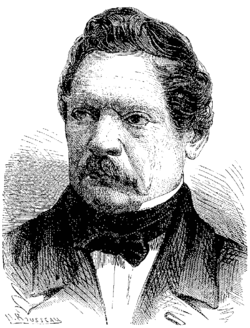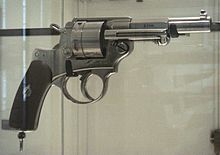
A rifle is a long-barreled firearm designed for accurate shooting and higher stopping power, with a barrel that has a helical or spiralling pattern of grooves (rifling) cut into the bore wall. In keeping with their focus on accuracy, rifles are typically designed to be held with both hands and braced firmly against the shooter's shoulder via a buttstock for stability during shooting. Rifles have been used in warfare, law enforcement, hunting and target shooting sports.

A bullet is a kinetic projectile, a component of firearm ammunition that is shot from a gun barrel. They are made of a variety of materials, such as copper, lead, steel, polymer, rubber and even wax; and are made in various shapes and constructions, including specialized functions such as hunting, target shooting, training, and combat. Bullets are often tapered, making them more aerodynamic. Bullet size is expressed by weight and diameter in both imperial and metric measurement systems. Bullets do not normally contain explosives but strike or damage the intended target by transferring kinetic energy upon impact and penetration.
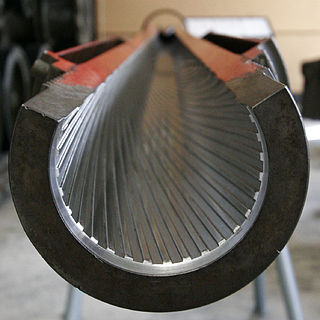
Rifling is the term for helical grooves machined into the internal surface of a firearms's barrel for imparting a spin to a projectile to improve its aerodynamic stability and accuracy. It is also the term for creating such grooves.

In guns, particularly firearms, but not artillery, where a different definition may apply, caliber is the specified nominal internal diameter of the gun barrel bore – regardless of how or where the bore is measured and whether the finished bore matches that specification. It is measured in inches or in millimeters. In the United States it is expressed in hundredths of an inch; in the United Kingdom in thousandths; and elsewhere in millimeters. For example, a US "45 caliber" firearm has a barrel diameter of roughly 0.45 inches (11.43mm). Barrel diameters can also be expressed using metric dimensions. For example, a "9 mm pistol" has a barrel diameter of about 9 millimeters. Since metric and US customary units do not convert evenly at this scale, metric conversions of caliber measured in decimal inches are typically approximations of the precise specifications in non-metric units, and vice versa.
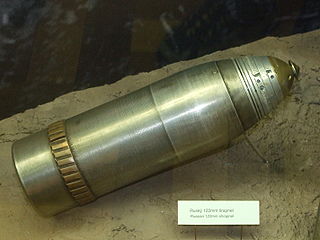
A driving band or rotating band is a band of soft metal near the base of an artillery shell, often made of gilding metal, copper, or lead. When the shell is fired, the pressure of the propellant swages the metal into the rifling of the barrel and forms a seal; this seal prevents the gases from blowing past the shell and engages the barrel's rifling to spin-stabilize the shell.

A gun barrel is a crucial part of gun-type weapons such as small firearms, artillery pieces, and air guns. It is the straight shooting tube, usually made of rigid high-strength metal, through which a contained rapid expansion of high-pressure gas(es) is used to propel a projectile out of the front end (muzzle) at a high velocity. The hollow interior of the barrel is called the bore, and the diameter of the bore is called its caliber, usually measured in inches or millimetres.
Internal ballistics, a subfield of ballistics, is the study of the propulsion of a projectile.
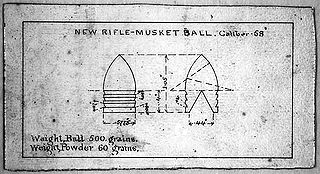
The Minié ball, or Minie ball, is a type of hollow-based bullet designed by Claude-Étienne Minié for muzzle-loaded, rifled muskets. Invented in 1846 shortly followed by the Minié rifle, the Minié ball came to prominence during the Crimean War and the American Civil War where it was found to inflict significantly more serious wounds than earlier round musket balls. Both the American Springfield Model 1861 and the British Pattern 1853 Enfield rifled muskets, the most common weapons found during the American Civil War, used the Minié ball.

The .303 British or 7.7×56mmR, is a .303-inch (7.7 mm) calibre rimmed tapered bottleneck centerfire rifle cartridge. The .303 inch bore diameter is measured between rifling lands as is the common practice in Europe which follows the traditional black powder convention.
A rifled musket, rifle musket, or rifle-musket is a type of firearm made in the mid-19th century. Originally the term referred only to muskets that had been produced as a smoothbore weapon and later had their barrels replaced with rifled barrels. The term later included rifles that directly replaced, and were of the same design overall as, a particular model of smoothbore musket.

The M1819 Hall rifle was a single-shot breech-loading rifle designed by John Hancock Hall, patented on May 21, 1811, and adopted by the U.S. Army in 1819. It was preceded by the Harpers Ferry M1803. It used a pivoting chamber breech design and was made with either flintlock or percussion cap ignition systems. The years of production were from the 1820s to the 1840s at the Harpers Ferry Arsenal. This was the first breech-loading rifle to be adopted in large numbers by any nation's army, but not the first breech-loading military rifle – the Ferguson rifle was used briefly by the British Army in the American Revolutionary War. The Hall rifle remained overshadowed by common muskets and muzzleloading rifles which were still prevalent until the Civil War. The early flintlocks were mostly converted to percussion ignition.

Polygonal rifling is a type of gun barrel rifling where the traditional sharp-edged "lands and grooves" are replaced by less pronounced "hills and valleys", so the barrel bore has a polygonal cross-sectional profile.
The Minié rifle was an rifled musket used by the infantry of a number of countries in the mid-19th century. A version was adopted in 1849 following the invention of the Minié ball in 1847 by the French Army captain Claude-Étienne Minié of the Chasseurs d'Orléans and Henri-Gustave Delvigne. The bullet was designed to allow rapid muzzle loading of rifles and was an innovation that brought about the widespread use of the rifle as the main battlefield weapon for individual soldiers. The French adopted it following difficulties encountered by the French army in North Africa, where their muskets were overtaken in range by long-barreled weapons which were handcrafted by their Algerian opponents.
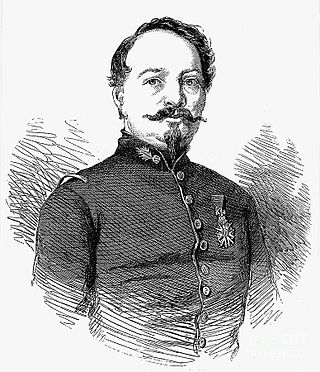
Claude-Etienne Minié was a French military instructor and inventor famous for solving the problem of designing a reliable muzzle-loading rifle by inventing the Minié ball in 1846, and the Minié rifle in 1849. He succeeded the pioneering work of Henri-Gustave Delvigne and Louis-Étienne de Thouvenin.
The following are terms related to firearms and ammunition topics.
A paper cartridge is one of various types of small arms ammunition used before the advent of the metallic cartridge. These cartridges consisted of a paper cylinder or cone containing the bullet, gunpowder, and in some cases, a primer or a lubricating and anti-fouling agent. Combustible cartridges are paper cartridges that use paper treated with oxidizers to allow them to burn completely upon ignition.

François Tamisier was a French artillery captain of the 19th century. He invented various methods to improve the rifled gun, particularly ball grooves.
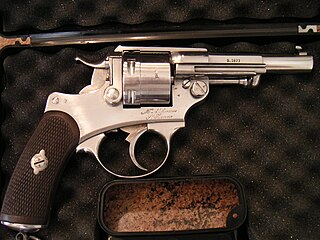
The service revolver model 1873 Chamelot-Delvigne was the first double-action revolver used by the French Army. It was produced by Manufacture d'armes de Saint-Étienne from 1873 to 1887 in about 337,000 copies. Although replaced by the Modele 1892 revolver, it was nevertheless widely used during the First World War and issued to reserve units in 1940. The French Resistance made widespread use of it during the German occupation.

The carabine à tige was a type of black-powder, muzzle-loading rifle invented by Louis-Etienne de Thouvenin. The method was an improvement of the invention of another Frenchman, Henri-Gustave Delvigne. Delvigne had developed chambered carbines and rampart rifle-muskets so that when forced against the chamber rim by ramming, the bullet would become deformed and flatten, so as to expand in diameter against the inside of the bore, allowing the bullet to press against the rifling grooves. When fired, the bullet accompanied the rifling and spun. This was an early attempt to work around one of the greatest hindrances to the use of military rifles; in order for a rifle to impart the proper spin to a projectile, the projectile must fit snugly inside the barrel to engage the rifling grooves. The problem, however, was that the black powder used at that time would quickly produce a thick layer residue of fouling. After only three or four shots, a typical rifle would be impossible to reload without using a mallet to force the bullet down the fouled barrel. Delvigne's design addressed this problem by introducing a projectile that was smaller than the bore of the barrel which after loading could then be struck with a ramrod. With three strokes of the ramrod, the bullet would become deformed and flatten, so as to expand in diameter against the inside of the bore, allowing the bullet to press against the rifling grooves. When fired, the bullet would accompany the rifling and spin. This improvement preserved accuracy while reducing the time required for reloading which would otherwise have been necessitated by the heavy fouling.
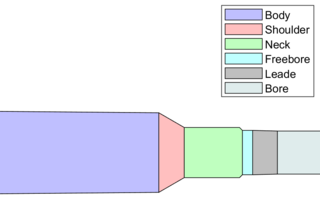
In firearms, freebore is the portion of the gun barrel between the chamber and the rifled section of the barrel bore. The freebore is located just forward of the chamber neck and is cylindrical in shape. The diameter of the freebore is larger than the groove diameter of the gun barrel bore so that no rifling is present and projectiles used in the firearm can accelerate through the freebore without resistance.
